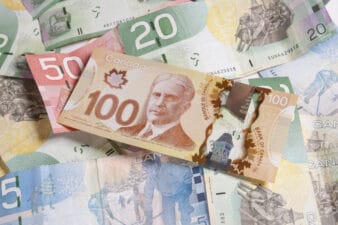The Canada Emergency Response Benefit (CERB) provides financial support to Canadians affected by the COVID-19. The dreaded coronavirus has wreaked havoc on the lives of the global populace. Canada imposed country-wide lockdowns in late March, resulting in business closures and lower consumer spending.
This drove Canada’s unemployment rate to 13.7% prompting the Canadian government to step in and launch a slew of financial measures to stabilize the country’s economy. The CERB is one such benefit that pays eligible Canadians $500/week for up to a period of 16 weeks.
Close to nine million Canadians have applied for the CERB since it was launched. The CRA has processed over $40 billion in CERB payments. However, according to a report from CTV News, Canada Revenue Agency (CRA) data suggests approximately 190,000 Canadians had to repay the CERB due to ineligibility.
The CTV report states, “The repayments are from people who were not eligible for the benefit. It could have been that they were unknowingly covered under another COVID-19 federal aid program; had been rehired during the time they were still receiving CERB; or had applied out of confusion during the early days of the program.”
The CRA is concerned over fraudulent practices and is cracking down on ineligible beneficiaries of the CERB. The Justin Trudeau-led government is likely to table a bill for Canadians deliberately seeking to avail the CERB payout, even though they are not eligible for the same. This might include a fine of $5,000 or even jail time.
The CERB is a temporary benefit
The CERB is not going to be a permanent federal government benefit and is likely to expire shortly. The maximum CERB benefit is $8,000 for a 16-week period. So, how do you generate $8,000 in annual cash flow?
Canadians can invest in real estate and look to rent out their property. But this requires significant capital and carries liquidity and pricing risks. There is another way to create a passive-income stream by investing in dividend-paying ETFs.
One such ETF is the BMO Canadian Dividend ETF (TSX:ZDV). This ETF aims to provide investors with exposure to dividend-paying stocks. These companies have the potential for long-term capital appreciation as well, which will drive the ETF price higher over time.
The BMO Canadian ETF is trading at $14.3, which is 23% below its 52-week high. This pullback has driven the ETFs dividend yield to a tasty 5.6%. The ETF’s top stocks with their respective dividend yield are as below:
- Enbridge has a forward yield of 7.8% and accounts for 3.22% of the ETF.
- Bank of Nova Scotia has a forward yield of 6.2% and accounts for 3.2% of the ETF.
- BCE has a forward yield of 5.8% and accounts for 3.2% of the ETF.
- Telus has a forward yield of 5.1% and accounts for 3.15% of the ETF.
- Emera has a forward yield of 4.7% and accounts for 3% of the ETF.
If you want to generate $8,000 in annual dividend payments, you can invest $144,000 in this ETF.







